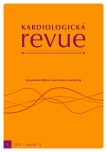Home monitoring and implants
Authors:
J. Lipoldová; H. Lipold
Authors‘ workplace:
I. interní kardioangiologická klinika FN u sv. Anny, Brno
Published in:
Kardiol Rev Int Med 2011, 13(3): 174-180
Overview
iotronik Home Monitoring is the most widespread remote-monitoring system in use in the Czech Republic. Data from the device is sent via GSM to a service centre and placed on a web-based database accessible to doctors. Individual implant models differ from each other in the form and the content of information transferred. From a practical point of view, it is necessary to pay attention to the correct programming of implant parameters and to the configuration of data monitored on the web-based environment. New models are capable of transferring intracardiac electrograms of a duration of up to 45 seconds. Many trials show high efficiency and the comparable safety level of remote monitoring compared to standard care. The progress of the remote monitoring of implantable devices is limited by technical, economical, legal and ethical considerations.
Keywords:
remote monitoring – implantable devices – Home Monitoring
Sources
1. Niederlag W. Communication Technologies for Improvement of Pacemaker Therapy. Prog Biomed Res 2001; 6 : 6–12.
2. Wallbrück K, Stellbrink C, Santini M et al. Biotronik GmbH, Technology & Service Center, Erlangen, Germany. The value of permanent follow-up of implantable pacemakers – first results of an European trial. Biomed Tech 2002; 47 (Suppl 1): 950–953.
3. Varma N, Stambler B, Chun S. Detection of atrial fibrillation by implanted devices with wireless data transmission capability. Pacing Clin Electrophysiol 2005; 28 (Suppl 1): S133–S136.
4. Sauberman RB, Hsu W. Technical performance and clinical benefit of remote monitoring of ICDs. Europace 2004; 6 (Suppl 1): 160 (abstract).
5. Heidbüchel H, Lioen P, Foulon S et al. Potential role of remote monitoring for scheduled and unscheduled evaluations of patients with an implantable defibrillator. Europace 2008; 10 : 351–357.
6. Osca J, Sanchotello MJ, Navarro J et al. Technical reliability and clinical safety of a remote monitoring system for antiarrhythmic cardiac devices. Rev Esp Cardiol 2009; 62 : 886–895.
7. Lazarus A. Remote, wireless, ambulatory monitoring of implantable pacemakers, cardioverter defibrillators, and cardiac resynchronization therapy systems: analysis of a worldwide database. Pacing Clin Electrophysiol 2007; 30 (Suppl 1): S2–S12.
8. Nielsen JC, Kottkamp H, Zabel M et al. Automatic home monitoring of implantable cardioverter defibrillators. Europace 2008; 10 : 729–735.
9. Ricci RP, Morichelli L, Santini M. Remote control of implanted devices through Home Monitoring technology improves detection and clinical management of atrial fibrillation. Europace 2009; 11 : 54–61.
10. Chan AQ, Chun S. Cost-effectiveness of wireless home monitoring pacemaker compared to conventional pacemaker (abstract). Pacing Clin Electrophysiol 2002; 24 : 534.
11. Fauchier L, Sadoul N, Kouakam C et al. Telemedicine in cardioverter defibrillator recipients: A benefit related to distance from institution. Europace 2004; 6 (Suppl): 161.
12. Fauchier L, Sadoul N, Kouakam C et al. Potential cost savings by telemedicine-assisted long-term care of implantable cardioverter defibrillator recipients. Pacing Clin Electrophysiol 2005; 28 (Suppl 1): 255–259.
13. Elsner C, Sommer P, Piorkowski C et al. A Prospective Multicenter Comparison Trial of Home Monitoring against Regular Follow-up in MADIT II Patients: Additional Visits and Cost Impact. Computers in Cardiology 2006; 33 : 241−244.
14. Piorkowski C, Hindricks G, Taborsky M et al. Homemonitoring in MADIT II Patients: A Prospective Randomized Multicenter Comparison Against a Standard Follow-Up (REFORM Trial). Circulation 2006; 114: II–749. Abstract 3513.
15. Halimi F, Clémenty J, Attuel P et al. Optimized Post-Operative Surveillance of Permanent Pacemakers by Home Monitoring: The OEDIPE Trial. Europace 2008; 10 : 1392–1399.
16. Brugada P. What evidence do we have to replace in-hospital implantable cardioverter defibrillator follow-up? Clin Res Cardiol 2006; 95 Suppl 3: III3–III9.
17. Varma N, Epstein AE, Irimpen A et al. TRUST Investigators. Efficacy and safety of automatic remote monitoring for implantable cardioverter-defibrillator follow-up: the Lumos-T Safely Reduces Routine Office Device Follow-up (TRUST) trial. Circulation 2010; 122 : 325–332.
18. Masella C, Zanaboni P, Di Stasi F et al. Assessment of a remote monitoring system for implantable cardioverter defibrillators. J Telemed Telecare 2008; 14 : 290–294.
19. Burri H, Senouf D. Remote monitoring and follow-up of pacemakers and implantable cardioverter defibrillators. Europace 2009; 11 : 701–709.
20. Lamaison D, Motreff P, Jean F et al. The place of telemedicine in rhythmology and cardiac pacing. Arch Mal Coeur Vaiss 2004; 97 : 1160–1164.
21. Deharo JC, Djiane P. Home Monitoring: what can we expect in the future? Clin Res Cardiol 2006; 95 (Suppl 3): III36–III39.
22. Schoenfeld MH, Reynolds DW. Sophisticated Remote Implantable Cardioverter-Defibrillator Follow-Up: A Status Report. Pacing Clin Electrophysiol 2005; 28 : 235–240.
Labels
Paediatric cardiology Internal medicine Cardiac surgery CardiologyArticle was published in
Cardiology Review

2011 Issue 3
Most read in this issue
- Antiarythmic treatment from the point of view of recent recommendations for the treatment of patients with atrial fibrillations
- Chronic cardiac failure with non-compact cardiomyopathy in a middle-aged woman
- Antithrombotic treatment from the point of view of new guidelines for the management of atrial fibrillation
- Home monitoring and implants
